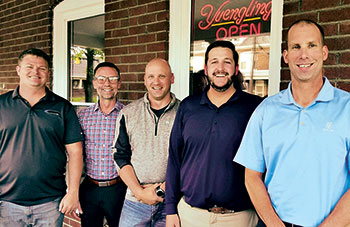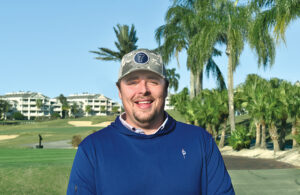PBI-Gordon’s turf bros

PBI-Gordon’s turf brothers. From left: Brian Aynardi, Ph.D.; Jim Goodrich; Jeff Marvin, Ph.D.; Eric Reasor, Ph.D.; and Jay Young. (Not pictured, Chris Williamson, Ph.D.) (Photo: PBI-Gordon)
Golfdom: Gentlemen, thanks for taking the time and getting everyone together here in San Diego. To start off, let’s give everyone a chance to introduce themselves and tell us a little bit about themselves …
Chris Williamson, Ph.D.: I’m Chris Williamson, I was a professor at the University of Wisconsin-Madison for about 20 years. I was the Extension entomologist, and the opportunity presented itself, so I came on board here. I am responsible for the Midwest, but I also cover Colorado, Utah, California. My expertise is entomology. I’m also a former assistant superintendent and a research scientist with TruGreen.
Jeff Marvin, Ph.D.: I’m Jeff Marvin, director of research. I organize our research internally and externally. I came out of undergrad at Penn State and I went to Florida, where I was a superintendent for about nine years. I wanted a career change, or more of a challenge — I don’t know if there is more of a challenge than being a superintendent — but maybe a different set of challenges. I went back to grad school at Clemson, worked on a Ph.D. there with Bert McCarty (Ph.D.) and joined PBI eight years ago.
Brian Aynardi, Ph.D.: I’m Brian Aynardi, I’m the Northeast research scientist. I’m a plant pathologist. I got my undergrad from Penn State in grass science in 2007, my Ph.D. from Penn State in plant pathology in 2016. I take leads on fungicide protocols. Then, basically from there, I oversee work on my territory, but I like to sneak into other territories when I can. Other than that, I just take orders from Jim and Jeff!
Eric Reasor, Ph.D.: I’m Eric Reasor (pronounced ‘razor’), I was hired back in December. I was an assistant professor at Mississippi State University, where I taught and did research. I have my undergraduate from Virginia Tech, graduate work at Tennessee. I work in the Southeast and the southern part of the country.
Jay Young: I’m Jay, an on-site project manager. I oversee all the herbicide business with PBI. I’m a former superintendent, I was a superintendent in Arkansas and an assistant in Atlanta. I’m also a former distributor rep. I’ve got a degree in turfgrass management from Auburn, and then an MBA from Webster University.
Jim Goodrich: I’m Jim Goodrich, fungicide, insecticides and plant growth regulators product manager. I’m a former golf course superintendent. I’m a Kansas State University graduate in turfgrass science. I also was a distributor sales rep for the Lesco Store-on-Wheels. I came to PBI 10 years ago.
Golfdom: What is the big news from PBI-Gordon for the 2019 Golf Industry Show?
Aynardi: It’s Vexis Herbicide Granular, our first proprietary molecule that PBI registered through a partnership with Kumiai Chemical. We received final registration in December of 2018. It has excellent turf safety, even on some really sensitive varieties like St. Augustine, which can be a little bit sensitive to some herbicides.
Reasor: We also launched Pedigree Fungicide SC. It controls brown patch, fairy ring, leaf and sheath spot. We’re just getting it introduced officially to the golf world. It’s a flowable suspension concentrate, safe on creeping bentgrass, Kentucky bluegrass, annual bluegrass, annual and perennial ryegrass, bermudagrass, zoysia and tall fescue.
Golfdom: The team of turf experts certainly has grown at PBI-Gordon. When did this investment in people begin?
Aynardi: I’m thinking back to when I was at Penn State, and I remember (Marvin) coming to that first field day, so that would’ve been 2012. So, if you go back to 2010 or early 2011, there was one researcher at PBI. Then in 2011, there were two, so basically from 2011 to 2016, for that whole time, there were never any more than two. And since 2016, it’s grown from two to now having four-full time researchers, plus a research farm. We have (Marvin) to thank for that.
Marvin: We have had not only an increase in manpower, but probably a four-time or five-time increase in our R&D spend.
Aynardi: I’m not saying this because he’s my boss, but really it is kudos to (Marvin.) You go back over the years since Jeff has been here, the amount of basic research we have and field work and R&D has just exponentially grown, to where now we have a lot of university guys saying, “Gosh, I’m going back through stuff this year, and you guys are our biggest supporters.”
Marvin: I was able to bring a true understanding of the need for research for PBI. As PBI grows, we’re growing into molecules that aren’t 40 years old. We’re growing into molecules we have to support from a data standpoint across the board, whether it’s registration, whether it’s public knowledge, how to use. So, as we move into that, there comes an increase in that knowledge base that we need.
Golfdom:This crew strikes me as a group that likes to work hard but also enjoys what they do. You all seem to have an energy for what’s going on within this turf team.
Williamson: I feel like this is a family. We’re like brothers. I mean, we obviously have a job to do. Jeff trusts us, we respect him, trust him, so I seriously don’t even think it’s a job some days.
Aynardi: My wife doesn’t understand this all that much, because I’ll be on the phone with these guys a lot of the time, like 8 o’clock at night, and she’s like, “Why are you still at work?” And I’m like, “I’m not really at work.” And she’s like, “Well you’re talking about work.” And I’m like, “Yeah but we’re also talking about fun normal life things … but we’re also talking about work.”
Reasor: We talk a lot of hockey.
Aynardi: We got to talk Penguins — I’m a big Penguins fan.
Golfdom: Not much crossover with golf turf and ice hockey, sorry guys. So, clearly you all get along, but what about the job itself … why work into the night on these things? Still got the superintendent work ethic in your blood?
Marvin: From my standpoint, and I think for any true researcher, it’s that idea of what’s next, figuring out what’s new, how to make something work. I think what probably drives just about every researcher out there is that puzzle piece. Beyond that, I truly enjoyed my time as a golf course superintendent. I look at this role that I have now as a bigger platform to impact the golf industry. You obviously can impact at a local, maybe a national, scenario for golf courses.
Aynardi: Working with some of the newer stuff we’re working on, including Union (Fungicide SC) along with Pedigree (Fungicide SC), has been really cool to see a lot of that come forward. Having worked with that stuff in grad school, working for a professor where I helped run his fungicide program, it’s like Chris said, you don’t even consider it working. Your job literally is to come up with things and try out new products that nobody else has gotten to work with! And I get to figure out these new rates and whether or not it’s safe. Or go out with crazy rates and see if it works on a disease that nobody expects it to work on. And every once in a while, you hit a jackpot where you come up with some idea, it’s a mix of something that’s just totally crazy, and it works. And I don’t know, to me that’s just an awesome thing to be able to get up and do every day.
Golfdom: What will we be talking about in a year from now, at the 2019 Golfdom Summit, or at the 2020 Golf Industry Show?
Marvin: From a standpoint of what’s next, I think we have some really nice options on the entomology side of things. I can’t go into specific details, but our R&D pipeline, I think, truly would rival any T&O business out there. I can say we have probably five to eight R&D projects and combinations that are on the books that we’re working toward. That’s what excites me. We will outpace the industry, and that’s our goal.
Goodrich: We have to be able to provide a solution the golf course superintendent wants. If it’s a me-too fungicide, we’re trying to stay away from that scenario, we want to develop a portfolio that golf course superintendents want to use and recognize the fact that our product is different from everybody else’s product. Right now, SDHIs are hugely prevalent in golf, and every time I talk to a golf course superintendent, whether it’s at the Golfdom Summit or at the Golf Industry Show, they’re like, ‘We want new products, we want new products, we want new products … Ah, but we don’t want that chemistry. We need something other than this chemistry or that chemistry’ … because everything new is a next generation and just seems to be the same or me-too. So that’s one of the things we do, and we have that flexibility. When we are overseas looking for molecules, we’ve had the ability to say, “No, we’re gonna pass on that one.” Or say, “Yeah, we want that one because it is different.”
Williamson: We’ve got some nice opportunities that are going to be presenting themselves, from my wheel house as an entomologist, there’s going to be great opportunities, so I’m really excited about that. I feel like we are in a really unique situation. From an entomological perspective, there’s some potential products coming down.
When we launched Segway, that was our entry back into the golf industry. Obviously, when we first launched Trimec or Fairway, way back when, the first gallon of that was sold on the golf course. We had that ad in Golfdom back in 1970. Segway reinvigorated PBI-Gordon back into golf. We want the golf industry to know that we’re here, and we’re here to support them, and that’s why we do the best at Golfdom Summit and we come (to the Golf Industry Show) and we have events for the superintendents. We want them to know we’re here and we’re ready to support them.
Young: I have superintendents sitting in front of me, they’re pretty passionate people. I think we still have that passion. We express it in different ways now in-house. Our passions are making solutions. We understand that passion part of it. We feel like we’re in a very unique opportunity and place right now because our focus is the turf and lawn care market, whereas some of our major competitors, especially with what’s gone on in the ag/chem industry over the last two or three years with mergers and acquisitions, a lot of business may be getting lost in some of our competitors’ business now. But our focus is strictly on the golf course superintendent and the lawn care operator. We feel like that’s an advantage for us.









